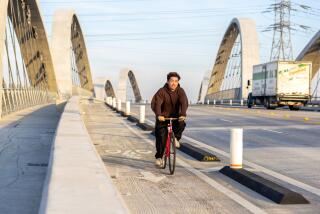Op-Ed: Is Eric Garcetti tackling climate change like he really means it?
- Share via
When it comes to climate change, Los Angeles Mayor Eric Garcetti talks the talk. Since President Trump pulled out of the Paris climate accords in 2017, Garcetti has repeatedly reaffirmed L.A.’s commitment to reducing greenhouse gas emissions. He has pledged to make the city carbon neutral by 2050.
Yet despite Garcetti’s enlightened climate oratory, transportation trends in L.A. are going in the wrong direction under his watch. Car use is ticking up, while Metro ridership has declined 15% over the past five years. Making the city more walkable is one key to increasing transit use, but pedestrian deaths have surged in spite of Garcetti’s “Vision Zero” street safety policy. Transportation now comprises the largest share of greenhouse gas emissions in California — with L.A. no doubt responsible for a lion’s share.
It takes strong, sustained leadership to change infrastructure and travel behavior. That means confronting inevitable resistance to change, and continually restating the need to make transportation in Los Angeles more balanced. It also means establishing specific goals and programs, and doggedly pursuing them. But instead of this kind of results-oriented leadership, the Garcetti administration is too fearful of motorist backlash to fully implement smart transit ideas.
There are far too many compromises built into Los Angeles’ sustainable transportation efforts.
Light rail slows to a crawl entering downtown because street signals prioritize cars. Buses move a majority of the city’s transit riders, but there are only three bus-only lanes on 7,500 miles of L.A. city streets. Reserving more lanes for buses would speed them through traffic and that in turn would help turn plunging ridership around.
Despite Garcetti’s enlightened climate oratory, transportation trends in L.A. are going in the wrong direction under his watch.
Under Garcetti, the city’s Department of Transportation “Great Streets” program — which aims to make streets less auto-oriented — is “transforming” less than one street a year. Sidewalks and safe pedestrian crossings near rail and bus stops are afterthoughts, where they exist at all. Even the process of fixing up bus-stop shelters is hopelessly mired in city bureaucracy, requiring approval from eight different city agencies.
Driving, meanwhile, remains relatively cheap and extensively provided for.
The mayor was supposed to change all this. Garcetti was Measure M’s strongest champion in 2016, rallying voters behind the country’s largest-ever transit funding initiative. But as the city has tried to move forward on transit gains, it has allowed decision-making to be held hostage by NIMBYs; the agencies he oversees are not empowered to push back and execute stated policy.
Meanwhile, Seattle and San Francisco have ongoing programs that each year deliver new bus lanes, more streets with traffic signals timed to move buses and light rail faster, and newly redesigned intersections where there were high rates of traffic crashes. Since 2014, San Francisco and Seattle, have installed, respectively, 27 and 35 miles of bus lanes. Leaders in those cities frame the need for these changes in clear terms, winning sufficient public support to move ahead.
Click here for the full Livable City archive »
When Garcetti references transit in L.A., he typically talks about rail. But rail will take decades to complete. Nor is it a sure bet for increasing public transportation ridership, absent improved pedestrian access and planning that treats rail and bus routes as integrated parts of a single system.
Garcetti should empower the Department of Transportation to create new dedicated bus lanes, and to change streetlight signal timing to prioritize transit over cars. He should launch a crash program to improve walking conditions around transit stations and high ridership bus corridors. Of course, city government needs to reach out to communities when it changes streets. But there is a fine line between seeking input on how best to achieve essential city goals and asking permission to pursue them.
Garcetti is a gifted orator. He has the ability to make it clear to Angelenos that there is a direct connection between fighting climate change and L.A.’s car addiction. The city needs him to use his rhetorical skills to push back against motorists who demand personal convenience over the future of our planet — and to back those words up with action.
Hayley Richardson and Jon Orcutt are the communications team at TransitCenter, a national foundation that works to improve public transit .
Follow the Opinion section on Twitter @latimesopinion or Facebook
More to Read
A cure for the common opinion
Get thought-provoking perspectives with our weekly newsletter.
You may occasionally receive promotional content from the Los Angeles Times.










